Porcelain Insulator News
by Elton Gish
Reprinted from "Crown Jewels of the Wire", July 1995, page 14
By the time you read this, my new book, Value Guide for Unipart and Multipart
Porcelain Insulators, will be available. Based on responses from more than 30
collectors across the country, it is the first comprehensive listing of all
known U.S. unipart and multipart porcelain insulators. The manufacturer,
marking, color, and value are given for each of the 3375 unipart and 826
multipart porcelain insulators, plus rarity and distinctive details are
indicated for unusual insulators. Additional listings are sorted by color and
manufacturer, and a U-Chart supplement is included which contains 86 new unipart
styles since Tod’s 3rd edition book was published in 1988. The size of the
142-page Value Guide is 8-1/2" x 11".
The idea for the Value Guide was born last year at the Houston National show
when several collector friends and I agreed there was a definite need for a
guide to help porcelain collectors. I immediately started putting together the
initial listing of unipart insulators after the show, thinking this would be an
easy project. Wrong! After the first survey was sent out asking for additional
listings, the unipart list doubled and tripled in size. The first survey was
followed early this year with both a combined unipart survey asking for values
and a multipart survey. I am amazed at the willingness of the 30+ collectors who
helped with this project and at the hundreds of hours each spent cataloging
their collection! It was an incredible joint effort by many eager friends!! I
feel like I had the easiest job of putting it all together. The surveys also
doubled as an inventory of unusual and rare porcelain insulators. The first
attempt at an inventory was done by Jack Tod in 1975. His inventory was very
narrow in scope; however, the limited result was interesting. The inventory part
of the Value Guide will help you determine approximate numbers or rarity of
unusual insulators which few people know today. This unique feature is important
in determining values. Please note, too, that the book was intended to be a
guide to values and not a price guide.
As if putting together the Value Guide was not enough to keep me busy, I
decided to reprint two classic Jack Tod books that were out of print. The
160-page Jack Tod book, Porcelain Insulators: Guide Book for Collectors, is
still in demand for its valuable information on the manufacture of porcelain
insulators, manufacturer’s histories, markings, and the U-Chart which shows
all the scale drawings and U-numbers for unipart porcelain insulator styles up
to 1988. The famous “Tod book” is a must for all collectors and an
invaluable partner to the Value Guide. Jack Tod’s 130-page book, Insulator
Patents, 1880-1960, has been out of print for several years. He spent thousands
of hours of patent search, and each of the 695 patents included in this book
specifically pertains to collectible insulators. Each entry has the patent
number and date, invention name, inventor, and a sketch of the insulator drawing
from the Official Patent Gazette. All patents are cross-indexed by date, patent
number, and use classification. The Value Guide and the two reprinted Tod books
are available from me. See the advertisement in the back of this issue for
prices and ordering information.
A number of interesting items and new insulator styles surfaced while working
on the Value Guide. Several people generously sent me insulators that either I
requested to see or they had questions about some of which were given new
U-numbers. We will be discussing many of these findings in this and future
columns. The U-Chart supplement part of the Value Guide also includes revised
drawings for Imperial insulators which were changed to remove any reference to
glaze-welding. As prominently discussed and pointed out in my book, Fred M.
Locke: A Biography, Imperial never produced an insulator by glaze-welding two or
three shells together (except for the few experimental insulators they made for
Fred Locke in early 1897).
One particular Imperial style that I had never seen was U-927. From Jack Tod’s
notes on that drawing, I learned that the drawing was based on an illustration
in the 1912 Thomas catalog. No specimen matching the drawing for U-927 was
reported until Errol Bond, Sr. (NIA #435) sent Jack a picture of his odd
Imperial insulator. Jack called Errol’s insulator U-927, and reported it in
the January 1980 (p. 32) issue of CJ. With the effort to revise all Imperial
U-Chart drawings to show them as non-glaze-weld styles, Errol generously agreed
to send his insulator for my inspection. Jeanne Bridges (NIA #1027) also sent me
a candidate Imperial U-927, but it did not fit the style either. THANK YOU
Jeanne and Errol for sending your insulators. As you can see in the photograph
and drawing, Errol’s insulator (center) does not quite match the drawing for
U-927. It appears to be an odd version of Imperial’s U-927C.
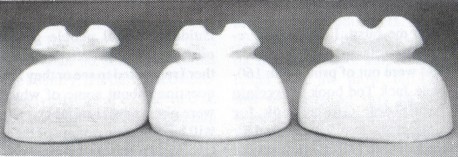
Imperial insulators: (l to r) U-710, Sim U-927C, and U-927C
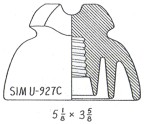
Errol Bond’s insulator |
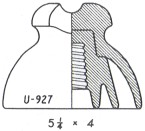
U-Chart drawing based on illustration in 1912 Thomas catalog (no known
specimens) |
This still leaves the question unanswered about the existence of a two-part
glaze-weld U-927 as shown in the 1912 Thomas catalog. Part of the answer
surfaced when Bob Stahr (NIA #4186) reported an odd two-part glaze-weld
insulator which did not match anything in the U-Chart. Specimens of this style
have been reported with and without the incuse Thomas marking on the crown, and
they have a typical Thomas mottled blackish/brown glaze. This new style was
assigned U-950 before the issue concerning Imperial U-927 Thomas two-part
glaze-weld could be resolved. The new U-950 drawing was passed around to several
collectors before we considered it to be the missing U-927 Thomas. One
alternative would have been to revise the drawing for U-927 to match the Thomas
specimens; however, the Thomas specimens (U-950) do not come close enough to
matching the illustration in the 1912 Thomas catalog (U-927). Note that the
pinhole was lowered on U-950, probably because they wanted the tie-wire groove
cut in deeper. The 1912 design would have proved too weak around the tie-wire
groove (where the outer shell was thinner close to the glaze-weld joint) after
the tie-wire groove was trimmed deeper. It is still possible that an even
earlier Thomas specimen will be found that matches the drawing for U-927. Until
then, no insulator specimens are known which can be cataloged as U-927.
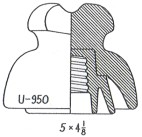
Thomas two-part glaze-weld
While on the topic of Imperial crown variations, this will be a good time to
point out variances in three Imperial U-710’s. The photograph on the next page
shows a brown U-710 (left) which has the Imperial “crown logo” marking and
the manufacturing date of 3-17-04. The white U-710 has a larger crown, the
Imperial “crown logo” marking, and the manufacturing date of 1-5-99. The
brown U-710 on the right was found with several others in 1994 by Bill Rosato
(NIA #2908). The crown is very different from the other two. It does not have
the Imperial “crown logo” marking, but it does have the Imperial marking #1
(see Tod’s 3rd edition Porcelain Insulator Guide Book page 131 for marking
details) and the manufacturing date of 9-30-02. All three insulators are
essentially (Sim) U-710. The crown differences are not sufficient alone to
require a new U-number.
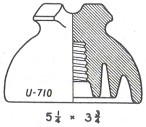

Three Imperial U-710’s with different crown details.
A very exciting find for Fred Locke collectors is a new style reported by
Bill Rohde (NIA #1219). He found this insulator at a show on the west coast. The
insulator (center in photograph) is very similar to U-964 except it is not a
two-part glaze-weld. The insulator was finely made from one piece of porcelain!!
It has been assigned U-964B. All of the U-964’s that I have seen had either
Fred Locke marking #6-1 or #7-1, but U-964B has marking #1-8. As I discussed in
my book, Fred M. Locke: A Biography, the single-date markings on larger
insulators were used before the 6-date and 7-date markings. I believe the U-964B
was produced circa 1900-early 1901, which means it was made before the U-964
style. Evidently Fred Locke considered the U-964 glaze-weld style to be easier
or cheaper to make. U-964 was made in a two-piece mold as were many other styles
at Victor from 1901 to 1904. A faint mold line can be seen across the dome of
most U-964’s. U-964B shows no such feature which means it was made by
conventional methods requiring the extra step of cutting the tie-wire groove
with a trimmer blade. Another advantage of glaze-weld styles is that the
critical operation of threading the porcelain section was simplified—the clay
shell was smaller and often interchangeable with one or more styles.
The U-964B specimen has a more uniform glaze color, thicker porcelain
sections, and better quality than U-964 specimens. It evidently was made during
the final months of Fred Locke’s law suit with Thomas over the Boch patent for
“glaze-filling”, when he was ordered to stop producing glaze-welded
insulators, and before he obtained patents for glaze-welding. When he ultimately
lost the case in November 1901 and submitted a patent application for a
glaze-welding technique in March 1902, the U-964B style was probably converted
to the cheaper U-964 style. A similar conversion apparently took place with the
replacement of U-669 (first produced on April 24, 1900) with U-675 however, most
U-669 specimens are dated in August 1901, which is later than the U-675’s
dated in the first half of 1901. You can see that it is difficult to determine
just what happened when only a few rare specimens are available.
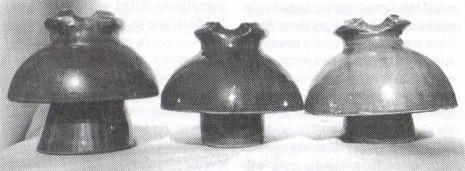
Fred Locke insulators: M-2250, U-964B, U-964
|
